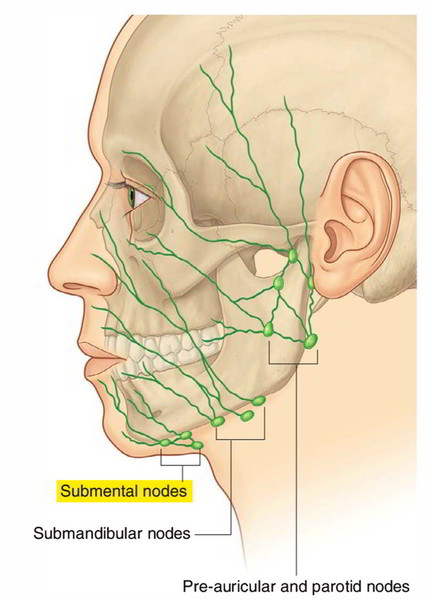The nurse assesses a client's submental lymph nodes. In which area of the client's head should the nurse palpate these lymph nodes?
In front of the ear.
In the midline, a few centimeters behind the tip of the mandible.
Superficial to the sternomastoid.
At the angle of the mandible.
The Correct Answer is B
Choice A reason:
Palpating in front of the ear would assess the preauricular lymph nodes, not the submental lymph nodes. The preauricular nodes are located just in front of the ears and are typically examined when there is an infection or inflammation in the eyes, ears, or scalp.
Choice B reason:
The submental lymph nodes are located in the midline, just under the chin, behind the bony prominence of the mandible. This is the correct area for palpation when assessing the submental lymph nodes. These nodes drain the lower lip, the floor of the mouth, the tip of the tongue, and the incisors, and they can become enlarged due to infections or malignancies in these areas.
Choice C reason:
Palpating superficial to the sternomastoid would assess the cervical lymph nodes, specifically the anterior cervical nodes, which are not the submental lymph nodes. The sternomastoid muscle is a landmark for several lymph node groups in the neck, but not for the submental group.
Choice D reason:
Palpating at the angle of the mandible would assess the submandibular lymph nodes, not the submental lymph nodes. The submandibular nodes are located beneath the jawline and can become enlarged due to infections or malignancies in the mouth, throat, and salivary glands.

Nursing Test Bank
Naxlex Comprehensive Predictor Exams
Related Questions
Correct Answer is B
Explanation
Choice a reason:
Immunization schedules are typically considered a part of primary prevention. They are intended to prevent diseases before they occur by using vaccines to provide immunity against infections.
Choice b reason:
Regular mammogram screenings are a form of secondary prevention. They are used to detect breast cancer lesions early before symptoms appear, which can lead to more effective treatment and better outcomes.
Choice c reason:
The consistent use of seat belts is a primary prevention strategy. It is a proactive measure to prevent injuries in the event of a motor vehicle accident.
Choice d reason:
Annual vision examinations can be considered part of secondary prevention if they are used to detect vision problems or eye diseases in their early stages. However, they can also be seen as primary prevention because they help maintain and protect eye health before issues arise.
Correct Answer is C
Explanation
Choice a reason:
A firm toothbrush is not recommended for plaque removal as it can damage the gums and tooth enamel. Soft-bristled toothbrushes are preferred because they are effective at removing plaque while being gentle on the gums and enamel.
Choice b reason:
Brushing more than twice per day does not necessarily irritate the gums unless done with improper technique or with a hard-bristled toothbrush. It is important to brush gently with a soft-bristled toothbrush and to use fluoride toothpaste to maintain oral hygiene and prevent gingivitis.
Choice c reason:
Ensuring that dental restorations such as fillings and crowns fit well is crucial in preventing gingivitis. Poorly fitted restorations can trap food particles and bacteria, leading to plaque buildup and gum inflammation. Regular dental check-ups can help ensure that restorations remain intact and do not contribute to gingivitis.
Choice d reason:
Flossing should not be avoided even if there is bleeding at the gumline. Bleeding can be a sign of gingivitis, and flossing can help remove the plaque and bacteria causing the inflammation. If bleeding persists, it is important to consult a dentist.
Whether you are a student looking to ace your exams or a practicing nurse seeking to enhance your expertise , our nursing education contents will empower you with the confidence and competence to make a difference in the lives of patients and become a respected leader in the healthcare field.
Visit Naxlex, invest in your future and unlock endless possibilities with our unparalleled nursing education contents today
Report Wrong Answer on the Current Question
Do you disagree with the answer? If yes, what is your expected answer? Explain.
Kindly be descriptive with the issue you are facing.
